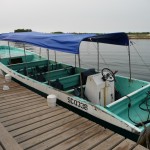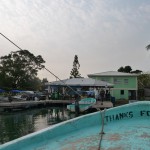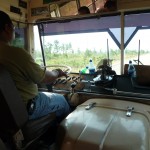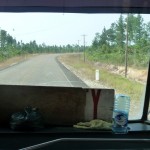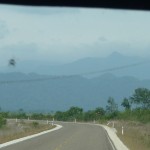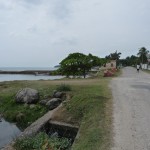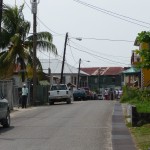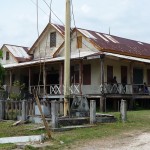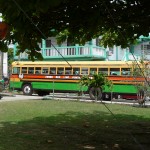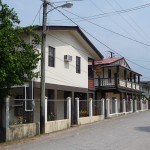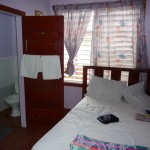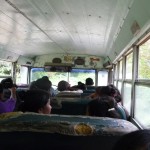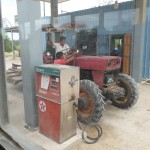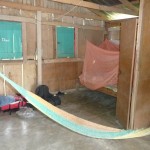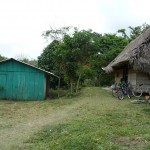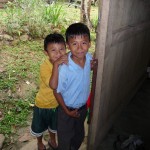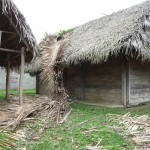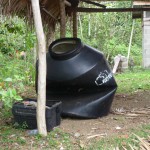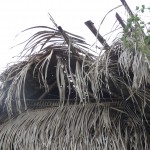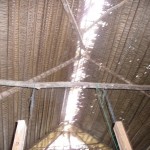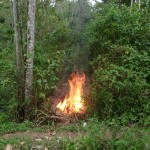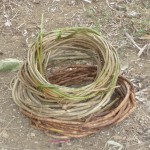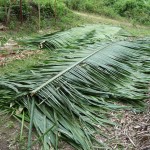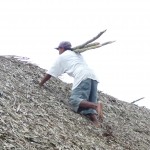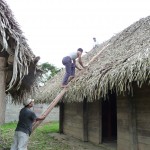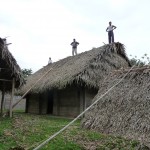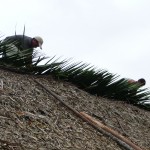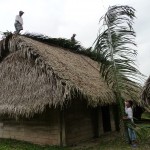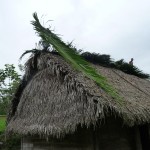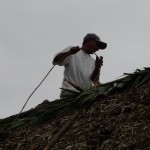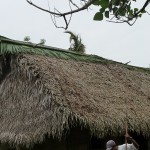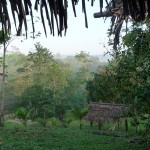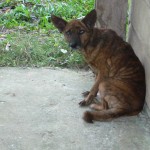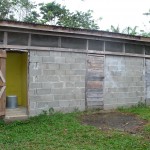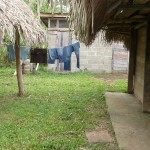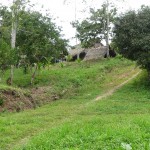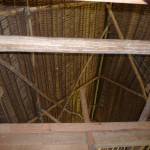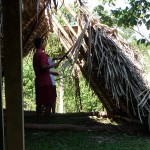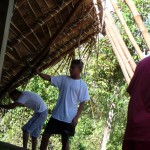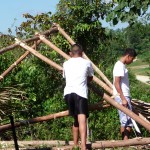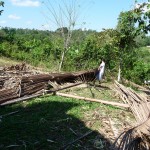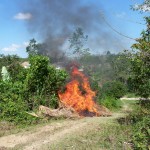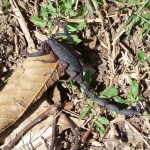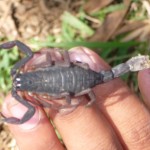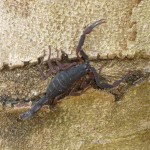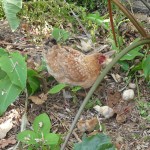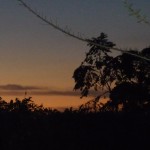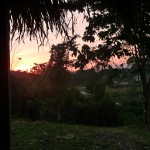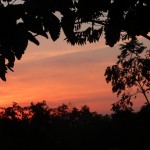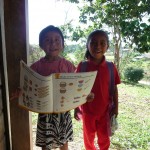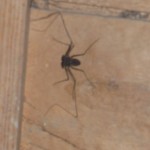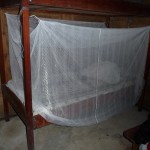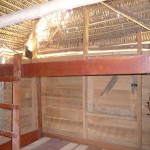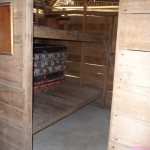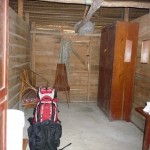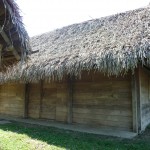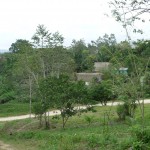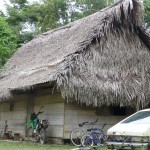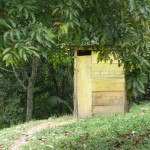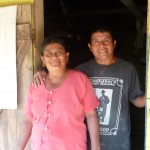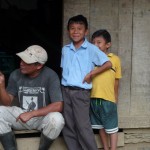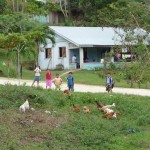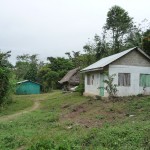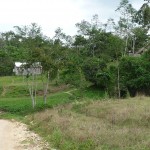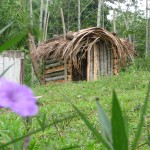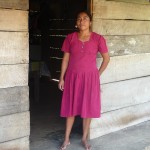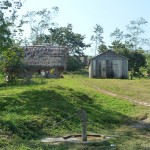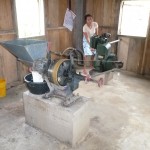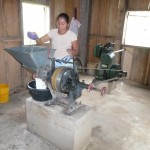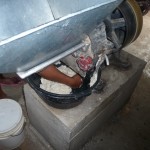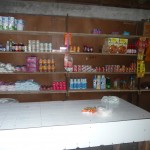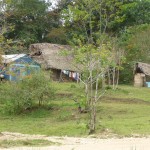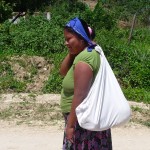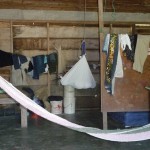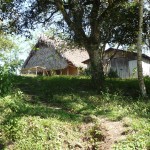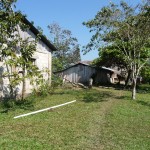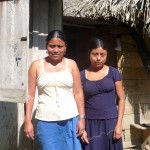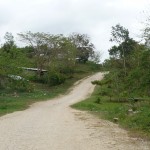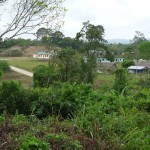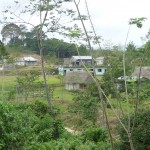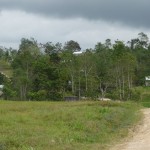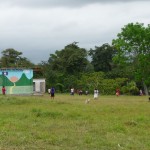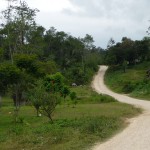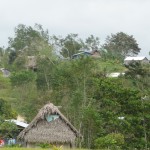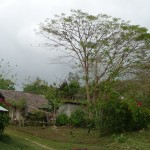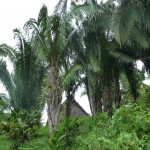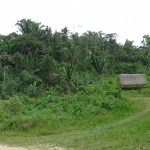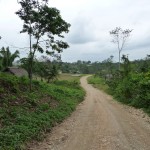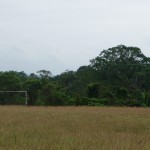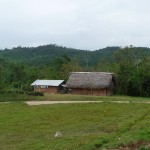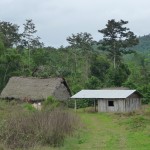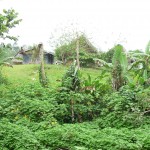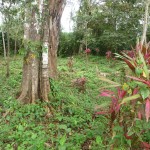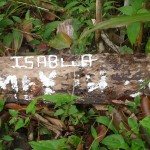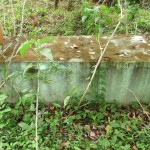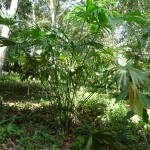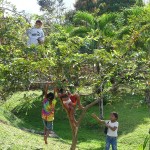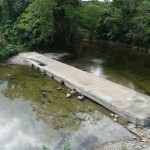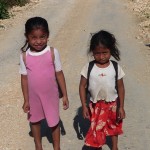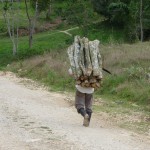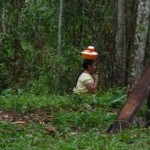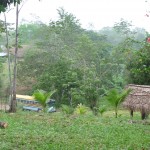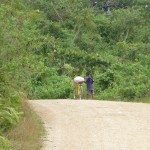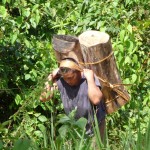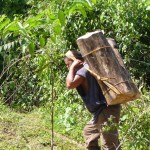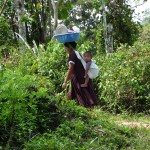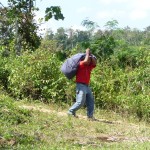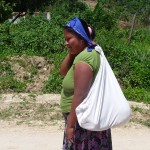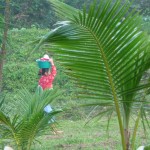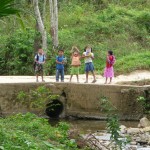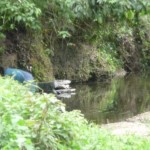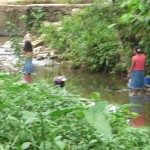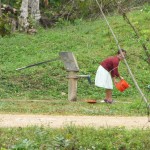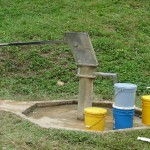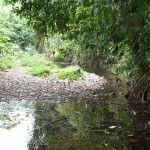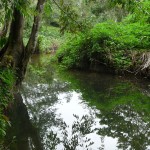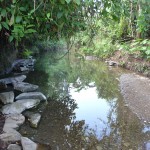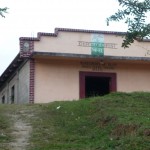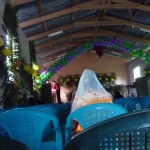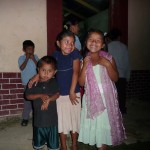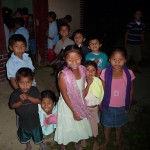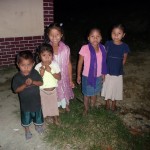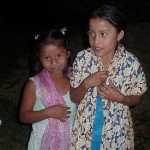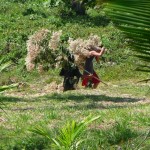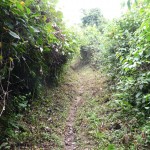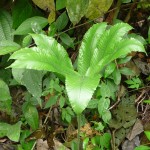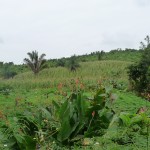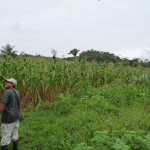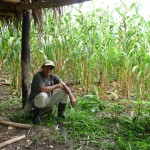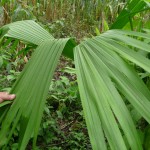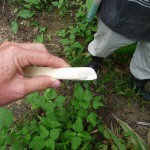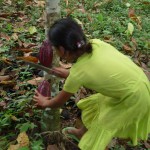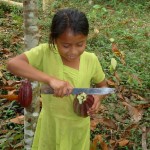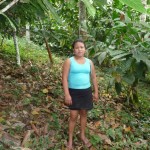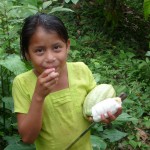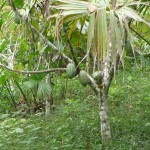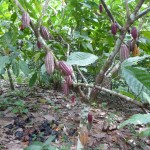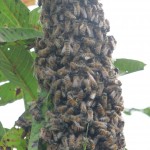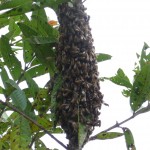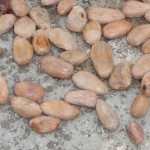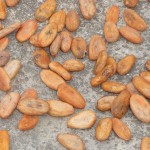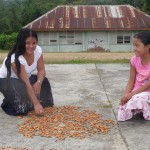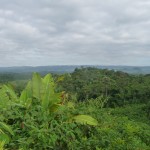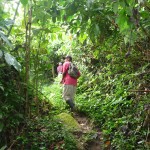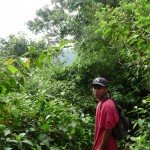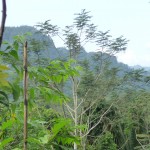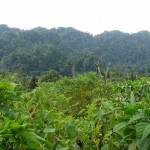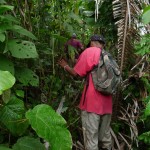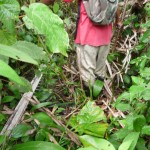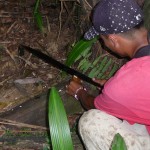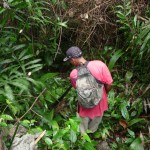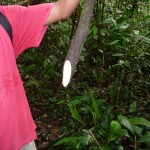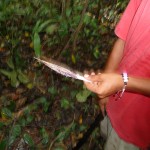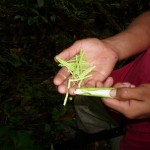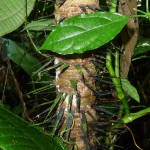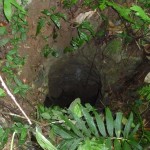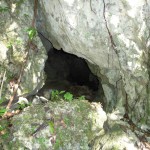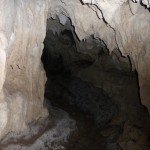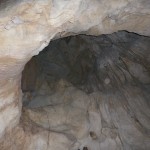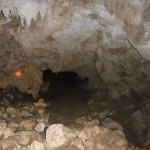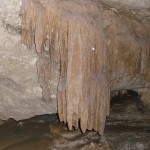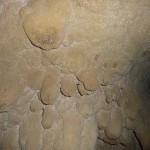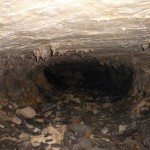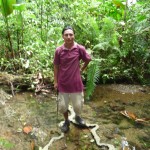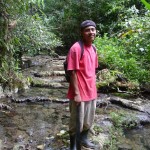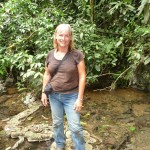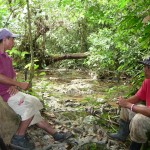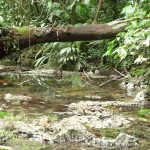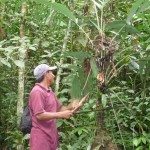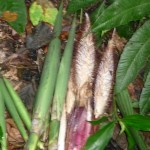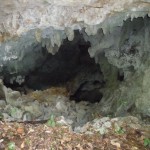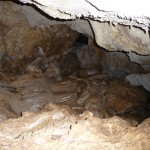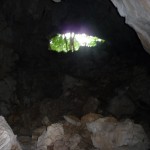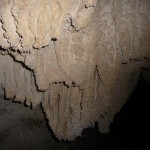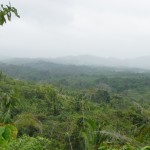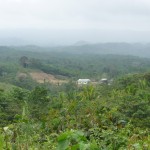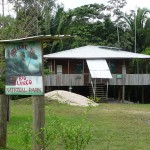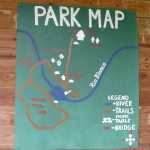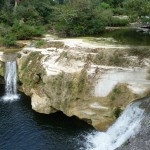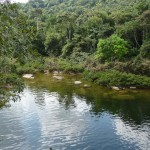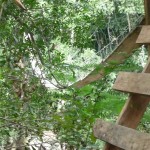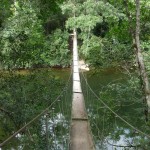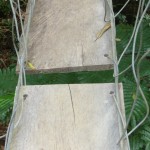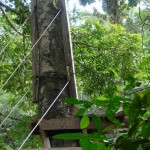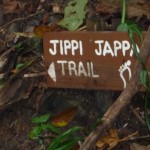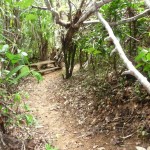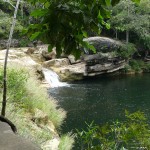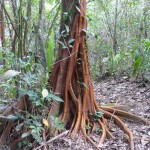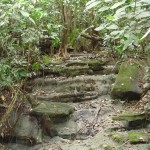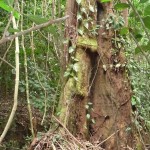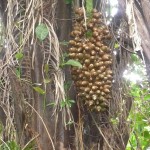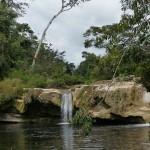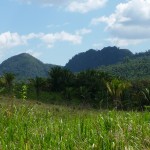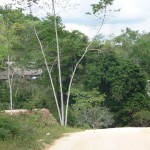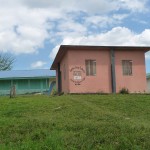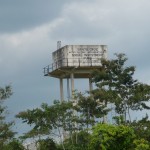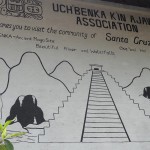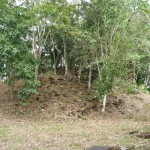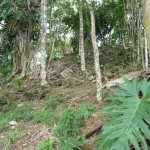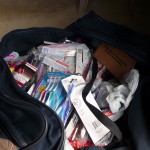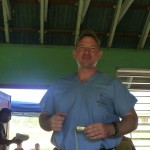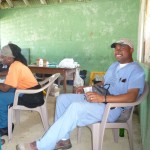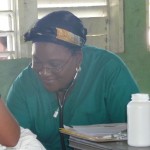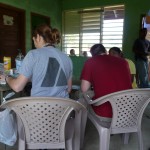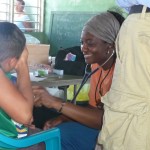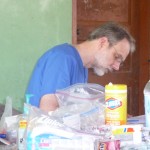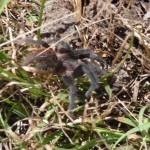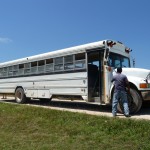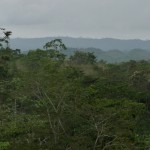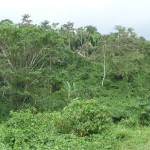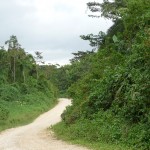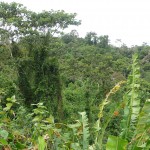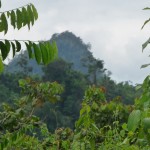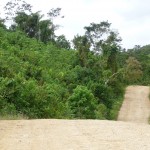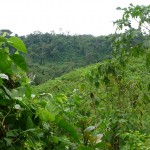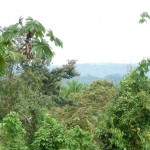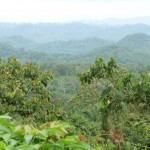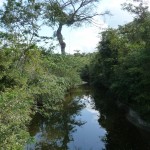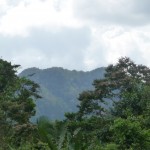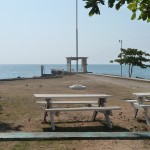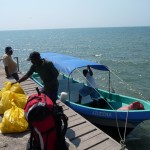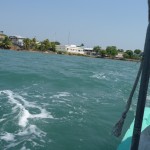During last week’s seven-day writing marathon, I could not help but make occasional conversation with a very friendly and cheerful fellow that passes by my bench multiple times every day. I soon find out that Domingo (Sunday) is originally from New York, but the world now seems to be his home.
Gradually, I learn that Domingo has been living here at Bruno’s for more than four months. He has a beautiful 42-foot trimaran (three-hulled) sailboat tied up here in the marina. During the course of his stay, Domingo has supervised the complete gutting out of the boat’s interior. Very soon, the ground-up remodeling job will be complete—with the majority of the boat’s interior being brand new.
“I’m preparing for a five year run with my boat.” Domingo tells me. “After passing through the Panama Canal, I will spend a year or two along the Pacific coasts of Panama, Costa Rica, and Nicaragua. Later, I will probably head south to Australia and other areas of the south Pacific.”
Throughout the course of the week, I learn a great deal more. This sweet good natured man is a semi-retired Chiropractor. Wherever he goes in the world, he practices his skills. Here in Rio Dulce, Domingo works his magic on the local people for free, while charging Gringos a mere $25 US.
After a few days, another very fun gentleman, Domingo’s friend Robert, enters the scene. As a very talented life-long musician, having played professionally for thirty six years, this fun and friendly guy is now 52 years old. He started making money with his traveling guitar at the tender age of 16.
Just three days ago, while I was still fully immersed in my marathon writing, Domingo approached me.
“Brenda,” he begins. “Robert and I have prepared a delicious bean stew for tonight. You are more than welcome to join us for dinner this evening if you would like.”
Monday night, shortly after 6:00 p.m., I find myself enjoying great food, and delightful conversation. As dinner winds down, and I am thinking it is probably time for me to graciously move on, Robert pulls out his guitar and begins an hour of entertainment. Domingo frequently sings along with Robert’s amazing mix of songs, ranging from Frank Sinatra to complicated Latin rhythms.
As I sit on the sofa, loving the experience of friendly serenading, I feel completely at peace, totally at home with two friends. It is nothing romantic, just a fun, vibrant friendship slowly developing between fellow travelers.
A New Perspective
“Brenda, before you leave Rio Dulce,” Domingo had told me, “you really need to visit Finca Paraiso.”
As Tuesday morning rolls around, my seven-day blog marathon is over, an amazing dream has just boggled my mind, and I am eagerly ready to spend a little time simply having some magical fun.
“Will my flip flops be adequate?” I ask Domingo, “And can you tell me where in town I might be able to buy a new flashlight?”
“Wait just a minute.” Domingo tells me, as he disappears into his hotel room.
Minutes later, I have in my temporary possession a pair of strap-on water sandals that are only a tiny bit too big, and a strap-it-to-your-forehead type of flashlight—one that will be perfect for my upcoming adventure.
Fifteen minutes later, with a small daypack on my back, I step onto the main street of Rio Dulce. As I look at the amazing display of unique cultural heritage that surrounds me, deep love is my guiding force, while confidence holds my hand. Gone is last night’s sense of nervous anxiousness. I feel no fear, no sense of danger. It seems that this morning’s powerful dream has shifted my heart in profound ways. I have indeed found a new perspective.
After stopping at a nearby store to pick up a few snacks, I follow Domingo’s directions to the main intersection in town, just two blocks to the north.
Sure enough, just as Domingo had told me, I see several vans parked near the corner. They all look basically the same, being white, dusty, beat-up, fifteen-passenger vans with luggage racks on top. What throws me off is that there is absolutely no signage in the windows.
“Do you pass by Finca Paraiso,” I ask one of the drivers with a slightly nervous tone.
“Yes, we will leave in about ten minutes.” He answers, as I let out a sigh of relief.
With no hesitation, I climb through the sliding side door, selecting a window seat on the left front bench. Glancing briefly around the inside, I note that there are four rows of seats crowded in the back. The very back bench runs the full width of the van, while the other three rows have a shorter bench—a bench with a small fold up seat on the right end. When loading rear benches, the seat is lifted, allowing people to pass. When traveling, the seat can be lowered, providing space for an extra person.
A few minutes later, after witnessing multiple items being placed on the roof rack, two Mayan women squeeze onto the front bench beside me. By the time we start pulling away, seventeen adults are crammed into this little transportation wonder.
Gradually, over the next thirty minutes, passengers get off at the occasional small village, or at a remote path leading into some trees. Frequently, a young man hops out of the van to retrieve these people’s belongings from the roof rack above.
I study the landscape around me. Both sides of the road are surrounded by small rolling hills. Occasionally, I can see the cool waters of the huge Lake Izabal to my left. On the right, taller mountains line the distant horizon. I am surprised by how dry the area seems. Most all of the jungle has long since been cleared. The road is surrounded by cornfields, banana plantations, and other miscellaneous orchards. Pastures with grazing livestock are also scattered throughout the area. With the exception of the well-maintained orchards, most of the open fields have a feeling of being parched, dry, and water deprived.
I am fascinated as I study the fences lining the winding sometimes-paved, sometimes-dirt, usually-something-in-between road.
“Those posts are growing,” I think with surprise as I do a double take. Then I realize that most of the posts are indeed growing. Sometime in the past, someone has planted tightly packed rows of trees lining both sides of the road—but for whatever reason the tops have been cut off. Rows of wire join these stumps together, most of which are trying to sprout new branches and leaves.
Finally a young man captures my attention.
“Finca Paraiso is right here.” He politely tells me.
“Over there? Toward the lake?” I ask, just trying to get my bearings.
“No, here on this side of the road.” He replies, while pointing off to the right.
I thank him as I step onto the hot dry ground below. My confidence is growing.
Thermal Shower
“Just walk that way along the river.” The sweet man tells me as he takes my 10 Quetzales ($1.25 US) at a small building near the main road.
“You will be there in about ten minutes.” He adds.
The first several minutes of the hike feel very hot, and dry. But soon, the trees thicken and the air temperature grows cooler, and fresher.
The small river below is a gorgeous dark green color. Many local villagers are gathered here and there, washing clothes, or bathing themselves. Suddenly, I detect a strong scent of sulfur, similar to what one might smell throughout Yellowstone.
“Of course,” I think to myself. “Domingo tells me that the waterfall here is fed by a hot spring. It only makes sense for the odor of sulfur to be present.”
The sulfur smell comes and goes, presumably depending on changing directions of the cool breezes.
As my hike continues, the trees continue to grow greener, the jungle slightly thicker.
Finally, as I crest a small hill, my destination appears—a large pool of water below, fed by a beautiful cascading waterfall of plunging hot water. After handing my handwritten ticket to Francisco, I speak briefly.
“Would it be possible for me to go to the caves?” I ask him.
“Yes, for 30 Quetzal additional, you can go there.” He begins, “but first you should swim here in the pool.”
Having worn my swimsuit underneath, I quickly stash my outer clothing in my small daypack. In a matter of minutes, I am gliding into the pool, first wading, with Domingo’s sandals shielding my feet from the rough rocks below. Soon, the bottom deepens, and I begin to swim.
The warm pool seems to energize my soul. The temperature is very enjoyable and pleasant. However, as I reach the base of the cascading water, I quickly note that the water falling from above is very hot indeed. A brief exposure only serves to warn and slightly sting, without actually burning the skin. Avoiding prolonged contact seems like a common sense behavior.
As I begin to think I have seen it all, I realize that I have not yet explored underneath the falls. Soon, I duck through a tiny opening in the spray and find myself in an eight-inch tall airspace between the water surface and the rocks above. The entire ceiling of this crawl space consists of colorful blue-green deposits of small growing stalactites. In fascination, I repeatedly investigate this less-explored area—an area that runs behind and under the full length of the falling waters, reaching five to eight feet back into the side of the hill.
As I begin to swim back toward the shore, I notice Francisco waving me up higher, to another pool of water above the falls.
Carefully climbing onto some rough uneven boulders, I scale a small incline until I am in a pool of fresh cool water fed by a small upstream river. Feeling a little internal nudge, I slide over close to the edge of the falls. While sitting on the rock, a six-inch-deep stream of cool water flows around both sides of my legs before plunging into the pool just six feet below. On my left, hot falling spray tickles my arms and cheeks. The energetic contrast is amazing.
For more than twenty minutes I remain still, absorbing the ambient energy of this highly unique experience—a cool freshwater stream merging with a hot thermal waterfall. Were it not for thoughts of my next exciting destination, I might choose to remain here all day.
A Near Fall
“It will cost fifty Quetzales to visit the caves.” Francisco tells me.
After reminding him that he originally told me thirty Quetzales, I quickly agree to pay the slightly higher fee. As I reach into my small purse, I realize that I only have a small amount of change plus two 100 Quetzal notes.
“Do you have change?” I ask hopefully.
“No, I am sorry,” he replies. “No tengo cambio.”
It only takes me an instant to search my heart. The additional 50 Quetzales is only $6 US, and my heart tells me that this is an adventure I simply cannot pass up. Without any hesitation, I hand him the 100 Quetzal note, and ask, “Will you guide me?”
Soon, Francisco tells me to follow him up a trail, saying it will be faster than walking along the river. Not thirty seconds into our climb, my unfamiliar sandals slip in the soft dirt of the steep trail, and I begin to slide slowly, uncontrollably, toward the canyon below. The lack of traction surprises me.
Looking up calmly with a smile on my face, I see two small trees about five feet below the trail. As my buttocks bounces off the hard dirt below, I gracefully place my feet against the base of the trees and hang onto the trunks. Were it not for these well-placed natural wonders, I most certainly would have continued a rocky slide over rough rocks, eventually ending up crash landing in the vicinity of the pool thirty feet below.
With a sore behind, and a little lesson behind me, I grin, wipe the dirt off my legs, and say “Estoy Bien, vamonos (I’m OK, let’s go).”
For the next twenty minutes, the climb is difficult and fast. Finally, I stop, bending over, gasping for breath, feeling like an asthma attack could easily arise at any minute—but it never does. Such an episode would surely have required my inhaler just a year ago—but I have not had a problem with asthma since beginning my travels.
“Can we please slow down?” I ask in between my panting breaths.
My body requires almost ten minutes of rapid breathing before I feel capable of moving my feet forward even one more inch. Finally, I tell Francisco I am ready, but we need to take it slow.
Ten minutes later, Francisco reassures me that the climbing portion of our hike is over.
“We go down from here.” He tells me with a smile. “Please go very slow and be very careful”.
And do we ever go down. The steep descent is covered with loose dirt and leaves. Tree trunks and other secure handholds are scarce. Zigzagging back and forth, we slowly make our way down the slippery dirt slopes, eventually returning to the small river below.
Even with Domingo’s unfamiliar, poor-traction rubber sandals, I somehow make it to the canyon bottom below without the slightest mishap—probably due to the little incident at the beginning of our hike that gently encouraged me to be extra surefooted.
“See that opening right there,” Francisco tells me casually, “That is the entrance to the cave.”
Swimming in Darkness
With a quick feeling of gratitude for Domingo, I carefully position the straps of his little hands-free light on my forehead. After turning on the switch, I make my way down the last few boulders, slipping gently into the pool of cool water below.
“You can swim about 250 meters into the cave.” Francisco tells me. “When you are done, I will be here waiting for you with your bag.”
The experience is like nothing I have ever done before—an incredible exercise into blind trust. It only takes me a second or two to realize that I cannot touch the bottom. The cave varies between six to eight feet in width, with the narrowing top rising perhaps thirty feet above me. Occasionally I find a small handhold to briefly hang onto the wall, and every so often, a shallow rock protrudes from the edge, giving me a place to stand or sit, but for the most part I must swim.
As daylight quickly disappears behind me, I realize that my light does not appear to be shining. Fiddling with my fingers in search of the sliding switch, I glance upward and see only two red dots where the light should be glowing. Seconds later, with a confident flip of my finger, my situation is remedied. The little light begins to shine brightly in whatever direction I turn my head.
I resume my slow dog-paddling aquatic advance into the darkness before me. The light behind is now but a distant memory. Fear is not in my vocabulary. A feeling of incredible awe overwhelms me as I begin to enter a waking meditative state, fully present in this moment.
Gradually, I recognize the rumbling sound of plunging water somewhere up ahead.
“Could there really be a waterfall in here?” I ask myself with wonder.
Pressing forward ever so slowly, I swim for a few seconds, and then search for a finger hold on the wall. Over and over again, I repeat this process while the rumbling continually grows louder.
Soon, I come up to a wall of debris—a pile of logs that partially blocks my path. Carefully, determinedly, I place one foot over the other, scaling this log, stepping over that one. After a six foot climb, I am back in another deep pool, again swimming toward the source of the now-roaring sound.
With one hand gripping the wall, I briefly extinguish my light, immersing myself in the wholeness of this moment, in the powerful energy of my surroundings. Then, with the light again shining, I swim around one final slight bend in the cave.
There, perhaps eight feet above me, is a three foot diameter circle of water powerfully surging from a round hole in the rocky wall. The rushing water gradually arches downward, plunging into the deep pool before me. For several minutes, I shine my light at the raging waters, mesmerized by my senses.
I swim ever so slowly as I gradually make my way back to daylight. I do not want this experience to end, but I realize that Francisco is waiting, and the afternoon is ticking away.
“How was it,” Francisco asks as I emerge into the bright daylight.
“Incredible.” I respond.
No other words are necessary.
Rainbow Connection
“Do you want to walk back down by way of the stream?” Francisco kindly asks.
“Yes, please … can we?” I respond, dreading the thought of repeating our former rise and fall.
Assuring me that he will keep my backpack dry, Francisco and I begin the half mile walk back down the river to the thermal waterfalls below. While the obstacles are slippery and going is slow, the river walk is beautiful and energizing.
As we near the falls, Francisco guides me up the side of the bank to the origin of the hot springs, following which he shows me a cave filled with large flying bats. Again, I think momentarily of my dear bat-loving friend Jeanette.
Upon arriving back at the magical thermal waterfalls, I am energetically pulled to repeat my morning explorations, swimming in and around every crevasse, both in front and behind the hot falls, thoroughly re-immersing myself in every experience.
As I once again sit in the cool stream with shallow water rushing past my legs, the bright sun shines above while a hot thermal mist settles all around me.
With wonder I look at the misty surface of the cool water to my left. Right before my eyes, hovering barely above the glassy water, is a small perfect 180 degree rainbow. In reverent silence, I meditate with my eyes open, basking in the energy of this spectacular unexpected light show.
With a giggle in my heart, I cannot help but picture a little green frog named Kermit, singing a beautiful little children’s song called Rainbow Connection.
The brief chorus passes through my awareness.
Rainbow Connection
Sung by: Kermit the Frog
Someday we’ll find it
The rainbow connection
The lovers, the dreamers, and me
Yes, I do believe in rainbows.
The dreamer in me will never stop searching for a deepening connection with the source of their magic.
Releasing Control
“Brenda,” Domingo interrupts me while I am writing on Wednesday.
“Robert and I have some business to take care of in Livingston.” He continues. “We’re taking a launch down the river on Friday. You are welcome to come along for the ride if you are interested.”
“Oh, thank you for the offer.” I reply. “But I plan on traveling north to Tikal on Friday.”
Thursday morning, as I prepare to continue tapping away on my laptop keyboard, a little Jedi voice kicks me in my unconscious buttocks.
“Brenda, what are you doing?” The little voice silently whispers. “Stay here two more days. Accept the offer for a fun day on the river. Trust me. Be flexible. Lose your defenses.”
Later that afternoon, as Domingo walks by my bench, I ask a simple question.
“Is your offer still good for tomorrow? I ask politely. “I would love to tag along on your river adventure.”
Monkey Mimicking
Early Friday morning, Domingo, Robert, and I pull away from the dock at Bruno’s Marina. Our little borrowed launch is much smaller than my previous water taxis. At barely five feet wide in the middle, the three-bench motor boat is probably about twelve feet long.
While cruising along through a wider section of the river, Robert yells back to Domingo, his voice barely carrying over the loud rumble of the outboard motor. Domingo slows down, momentarily quieting the engine.
“Last time I was here,” Robert begins while pointing off to the distant right, “the guy I was with took us to the shoreline over there. He did his best imitation of a howler monkey, and soon we had a whole group of them howling back at us along the shoreline. It was a hoot.”
Within minutes, we are drifting up near the shoreline, the motor now completely silent.
Looking toward the trees, Robert suddenly lets out a loud burst of moaning howls, doing his best to imitate the incredible sounds of the howler monkey.
Seconds later, off in the distance, we hear a loud moaning, howling response from what sounds like a relatively large group of howler monkeys, perhaps several hundred yards inland.
Then I hear an even more authentic imitation of loud monkey roars coming from Domingo, right behind me. I begin to laugh uncontrollably as almost immediately we get an even louder response from this testosterone-driven group of swinging mammals somewhere out in the jungle.
For fifteen minutes, I cannot help but giggle as Robert and Domingo take turns trying to call our unseen friends to come a little closer. It seems that I am having more fun watching and listening to Robert and Domingo than I could possibly have by simply observing a few wild monkeys in the trees.
Unsuccessful in our efforts to draw the monkeys to the shoreline, Domingo soon restarts the noisy outboard motor, turns the bow of the boat back out into the river channel, and resumes our rapid 20 mph westward journey over the still-smooth waters of the Rio Dulce.
Hot Springs Revisited
“These canyons are indeed beautiful.” I think to myself as I reminisce about a journey that took place almost two weeks ago—the very same short boat ride that brought me from Livingston to Finca Tatin on my second day in Guatemala.
Now, I am honored with the privilege of seeing this beautiful panoramic vista, not just one more time, but twice in a single day.
After spending a few hours, first enjoying a mid-morning breakfast, then briefly walking through the main streets of Livingston, the three of us begin our casual return boat trip back up the Rio Dulce, treating ourselves once again to the vistas of these gorgeous canyons.
“Bring your swimsuit.” Domingo had told me earlier. “We might stop at the hot springs on the way back.
As we pull up to a little riverside thatch-roofed restaurant in the middle of nowhere, I notice the name “Agua Caliente (hot water).”
“Of course,” I tell myself as I recognize the same little building that I had struggled to pass on my kayak. This is the exact spot where I had paddled forcefully through wind and waves while water poured onto my lap near the end of my long five-hour kayak adventure.
After tying up at the small dock, we are soon sitting in a pool of river water not more than ten feet away. The scent of sulfur wafts through the air as we drift around in shallow water by the bank of the Rio Dulce. Small streams of steaming hot water trickle out of cracks in the adjacent hillside, quickly mixing with the cool waters all around us.
As I quietly inhale the amazing feeling of these warm and cool waters mixing around me, I cannot help but reminisce about an energizing experience from only three days ago—an experience where I meditated in cool flowing waters while the midday sun shined down on hot steaming mists falling all around me.
In my mind, I see a beautiful rainbow dancing on the surface of those cool stream waters, peacefully reminding me that the magic of rainbows really does exist.
Copyright © 2010 by Brenda Larsen, All Rights Reserved
